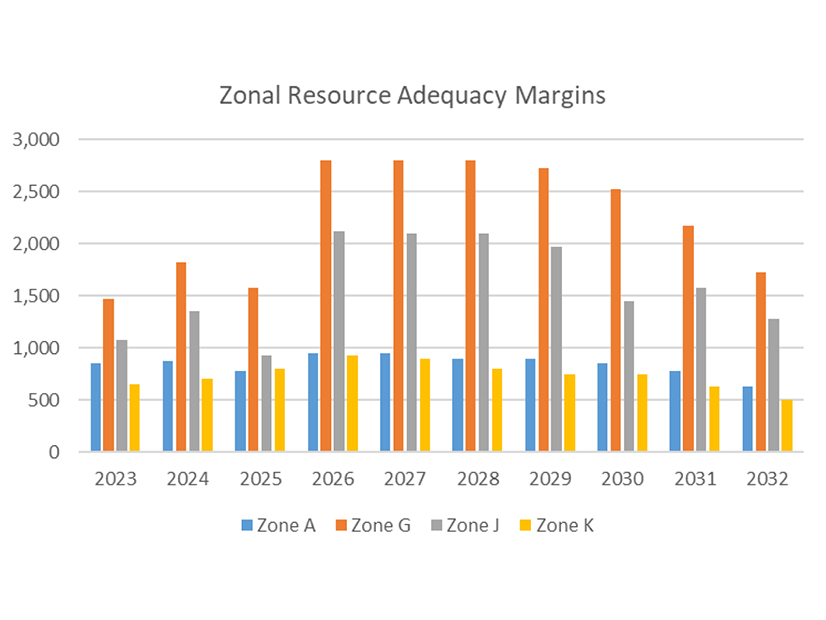NYISO is planning to narrow the scope of its system reliability impact studies (SRIS) and revise its pro forma interconnection agreements in response to resource challenges and the unprecedented increase in the number of generator interconnection requests.
ISO officials outlined the proposed changes at the Sept. 1 Transmission Planning Advisory Subcommittee (TPAS) and Electric System Planning Working Group meeting.
Despite an increase in staffing, the workload for the ISO’s interconnection studies (IS) team has doubled since 2018 when six engineers managed 120+ studies, about 20 per engineer. This year, the ISO’s nine engineers are managing 346+ studies, an average of 40 each.
Productivity also has been hampered as the ISO had to replace five engineers on the IS team between January 2021 and March 2022, meaning two-thirds of the team lacked interconnection experience.
These problems have been exacerbated by labor market shortages, which prevented consultants from taking on more projects, and more customers requiring personalized attention because of their unfamiliarity with NYISO processes, Thinh Nguyen, senior manager of interconnection projects, said.
NYISO attorney Sara Keegan said the volume of interconnection requests is also taxing the ISO’s legal team.
As a result, Nguyen said the ISO plans to eliminate from the SRIS for large facility interconnections the voltage deviation analysis and harmonic analysis and perform other analyses — NPCC A-10 testing, transfer assessments and sub-synchronous torsional interaction screenings — on a case-by-case basis.
The streamlining of the SRIS process is in addition to other changes the ISO has made to address the growing interconnection queue and address the labor shortage, including a salary study that resulted in pay increases for engineers and the planned hiring of staff to help guide project developers through the interconnection process. (See NYISO Details 2023 Budget & Compensation Updates.)
Stakeholders agreed that elements of the SRIS study were redundant for projects that go through class year studies.
In addition, Keegan said the ISO will seek FERC approval for changes to its pro forma interconnection agreements and the creation of a pro forma engineering, procurement and construction (EPC) agreement for some system upgrade facilities (SUFs) and system deliverability upgrades (SDUs).
Keegan said the ISO will propose revising the small (SGIAs) and large generator interconnection agreements (LGIAs) to add placeholders to address recurring variations that have necessitated non-conforming agreements and clarify security, invoicing and oversight cost rules, among other changes.
 NYISO large generator interconnection procedure | NYISO
NYISO large generator interconnection procedure | NYISO
The pro forma EPC agreement would cover SUFs and SDUs not addressed in LGIAs or SGIAs because the upgrades are required for affected systems or for multiple projects, Keegan said. She noted that FERC has approved such an agreement for MISO and has proposed an agreement for affected system in its generator interconnection Notice of Proposed Rulemaking (NOPR) in June (RM22-14). (See FERC Proposes Interconnection Process Overhaul.)
NYISO anticipates presenting the interconnection agreement related tariff revisions at either the Oct. 3 or Nov. 1 TPAS meeting and is targeting Q1 2023 for a Section 205 filing with FERC. NYISO also anticipated additional revisions in 2023 as part of a project proposed by the Alliance For Clean Energy New York and through an expected compliance filing from FERC’s final order on the generator interconnection NOPR.
Nguyen also outlined plans to revise the base case inclusion rules used in the interconnection studies to ensure the studies incorporate transmission and class year projects that may impact each other by using existing system capacity or requiring similar upgrades.
The ISO said it expects discussion of proposed tariff changes through the third quarter. It said written comments should be sent to Kirk Dixon (kdixon@nyiso.com).
RNA Draft Report Finds No Immediate Needs
The 2022 Reliability Needs Assessment (RNA) found that there were no reliability needs on the New York bulk electric grid through 2032.
While the report found the ISO’s grid will meet all reliability criteria based on forecast demand and expected weather, it said the reliability margin could be narrowed or eliminated, based upon changes in forecasted system conditions.
“Delayed implementation of projects in this plan, additional generator deactivations, unplanned outages, changes in load patterns and extreme weather could potentially lead to deficiencies in reliable electric service in the coming years,” the report said.
The report said reliability margins will likely shrink in the future because of the unavailability of simple cycle combustion turbines because of environmental rules, including the state Department of Environmental Conservation’s Peaker Rule, which will reduce nitrogen oxides emissions from CTs in a phased implementation from 2023 to 2025.
“Additionally, significant load-increasing impacts are forecasted due to expected growth in electric vehicle usage, large cloud-computing data centers and other electrification (i.e., conversion of home heating, cooking, water heating and other end-uses from fossil-fuel based systems to electric systems),” the RNA said. “However, additional resources planned to be in-service in the near-term horizon, such as the Champlain Hudson Power Express connection from Hydro Quebec to New York City, provides a boost to the margins. Additionally, the NYISO is forecasting over the next ten-year period a decrease in energy usage due to energy efficiency initiatives and increasing amounts of behind the meter solar generation.”
“While we don’t have reliability needs in the study period, the margins are not far from tipping,” the ISO’s Laura Popa told the two committees.
The RNA is the first step of the ISO’s reliability planning process. The grid operator plans to issue its 2023-2032 Comprehensive Reliability Plan in 2023. Any needs identified in the short-term reliability process in year one through year three will be addressed in its quarterly short-term assessments of reliability.
NYISO requested comments or questions be submitted to either Laura Popa (lpopa@nyiso.com) or Kirk Dixon (kdixon@nyiso.com) by Sept. 6. The ISO is targeting Sept. 19 for its third RNA draft and then submitting the report for board approval in November.



